Contents
Summer is a great time to saturate the body with vitamins, trace elements and fiber contained in fresh vegetables. However, summer is short, and vegetables on our table should be in any season. Only with proper nutrition can you maintain youth and health for many years. This is where the question arises: how and where to store vegetables in order to extend the vegetable season. One of the important food products are all kinds of cabbage: white, red, Beijing, cauliflower, broccoli and many others. Some types of cabbage are stored in the cellar until spring.
Cabbage is sold in markets and shops all year round, but its appearance does not always inspire confidence, the price does not always match the quality, and in spring the cost of vegetables becomes sky-high. It is no secret that in industrial production, cabbage is treated with chemicals so that it grows better and lasts longer. The conclusion suggests itself: if a person is not indifferent to what to eat, then you need to grow it yourself, and figure out in advance how to properly store vegetables in storage for the winter, how to save cabbage until the next vegetable season.
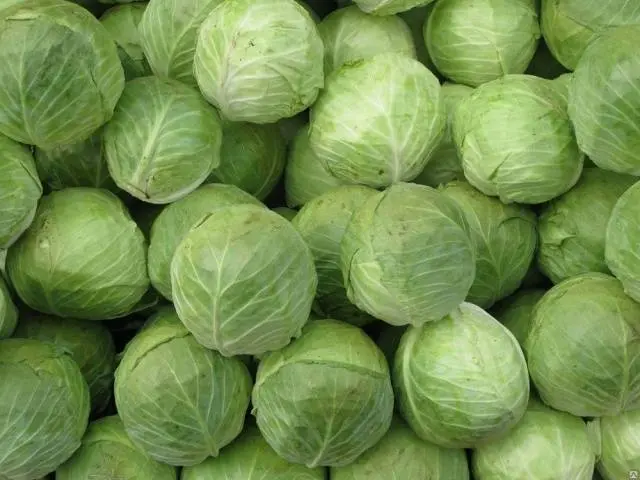
Variety choice
Only late-ripening varieties of cabbage are suitable for winter storage, since they have a higher density compared to heads of early-ripening varieties and are less prone to rotting. To select a cabbage variety, check out the table.
|
|
If you don’t have a personal plot, or you don’t have the opportunity to grow cabbage on your own, you buy it in a store or in the market, and you don’t know which variety is in front of you, then visually determine whether this cabbage can be stored in the cellar in winter. Choose medium-sized rounded, slightly flattened, firm forks. Oblong and loose heads of cabbage are unsuitable for long-term storage.
Preparing cabbage for storage
Cabbage grown in your own garden, and intended for winter storage, must be collected in accordance with the growing period, it is not necessary to overexpose it in the garden. Choose a dry, warm day to harvest. Carefully dig up the heads, clean the stalk from the ground, but do not remove it. Sort the harvested cabbage. Leave small and damaged cabbage for harvesting. Leave 2-3 wrapping sheets, fold the cabbage under a canopy for ventilation. Make sure it is not exposed to rain or direct sunlight. Leave the roots or cut them off depending on the chosen storage method.
Long term storage methods
The most common is the storage of cabbage in the cellar. Heads of cabbage can be hung, wrapped in paper or food stretch film, cabbage can be covered with sand, or even dipped in a clay mash. The temperature range for storing cabbage is small, from 1 to 3 degrees C0. We will consider each of these methods in detail and show you how to prepare the cellar itself.
in paper

Wrap each head of cabbage in several layers of paper. This method isolates the heads of cabbage from each other, preventing them from touching and infecting each other. Paper creates additional thermal insulation, protects from moisture and light. Carefully arrange the heads of cabbage wrapped in paper on the shelves or put them in boxes. Make sure the paper is dry. When wet, the paper will cause accelerated spoilage of the cabbage.
In film
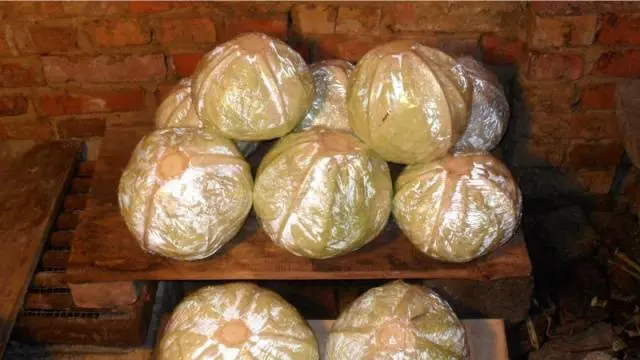
You can save cabbage in the cellar with polyethylene. Take cling film in rolls. Wrap each fork tightly with several layers of cling film. Elastic, well-fitting polyethylene will keep the cabbage well into spring, providing moisture resistance. Place packed cabbage on shelves, or put in boxes.
In a pyramid

Build a wooden platform at a height of about 10 cm from the floor, leaving small gaps between the deck boards. In the bottom row, in a rectangle, lay the largest and densest cabbage forks. Place smaller heads of cabbage in the second layer in a checkerboard pattern. Continue laying out the pyramid, laying the sprouts on top, which will be used first. Air circulates between the cabbage, preventing rotting. The disadvantage of this method is that if the cabbage in the bottom row deteriorates, the whole procedure will have to be repeated, removing the rotten head of cabbage.
In the boxes
The easiest, although not the most efficient way. After cutting the stalks, removing excess leaves, lay the heads in ventilated wooden boxes. Put the boxes not on the very bottom of the cellar, but on pallets, this will slow down the damage of heads of cabbage. It is not necessary to cover the lid, let the air circulate freely inside the cabbage box.
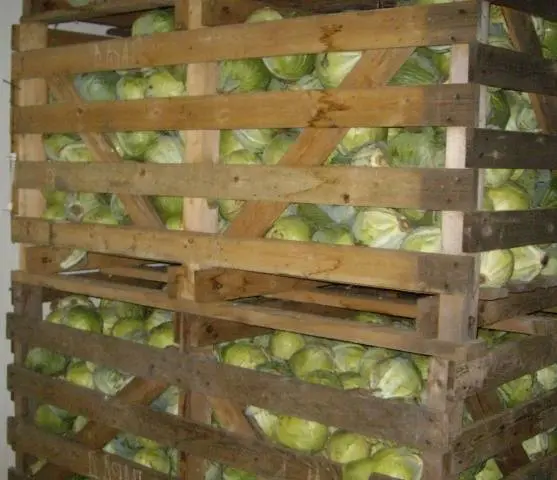
In sand
A troublesome, dirty, but quite successful method. Put the cabbage in large boxes, sprinkled with dry sand in layers. You can simply pour sand on the bottom of the cellar, and put heads of cabbage in the sandy hill.
On suspension

An efficient, environmentally friendly, but space-consuming method. For this storage option, the roots are not cut off. Fix an inch board under the ceiling, maintaining a distance of at least 30 cm from the cellar walls, drive nails into the side of the board at equal distances so that the largest head of cabbage passes freely between them. Fasten one end of the rope to the stalk, the other to the nail. One head of cabbage should hang on one nail. The crop is ventilated, clearly visible, you can immediately notice damage. For small crops, this is an ideal storage option.
Clay shell
The method is original, and in our time exotic. Coat each head of cabbage on all sides with clay (dilute the clay with water until the density of sour cream). Dry until completely dry. Cabbage protected from external factors should be laid out on shelves or put in boxes.
Any of these methods of storing cabbage will be effective if the cellar is properly prepared for winter.
Preparing the cellar for winter
If your site has a separate cellar or basement under the house that can be used for winter storage of vegetables, inspect this room in advance and eliminate the shortcomings so that by the time the cabbage is harvested and stored for storage, the cellar is dried and disinfected. If the cellar was previously used for storing crops, remove plant debris and debris from there. The cellar must be well waterproofed to prevent groundwater seepage. Signs of increased humidity are drops of water on the walls and ceiling of the cellar and stale, musty air. Thoroughly ventilate and dry the cellar by opening doors and hatches. A good solution for normalizing humidity is supply and exhaust ventilation, if it is not provided, then boxes with salt or charcoal can be placed in the corners, this will also reduce the humidity to some extent. About a month before laying vegetables, whitewash the walls and ceiling with quicklime: it dries the air and disinfects the surface.
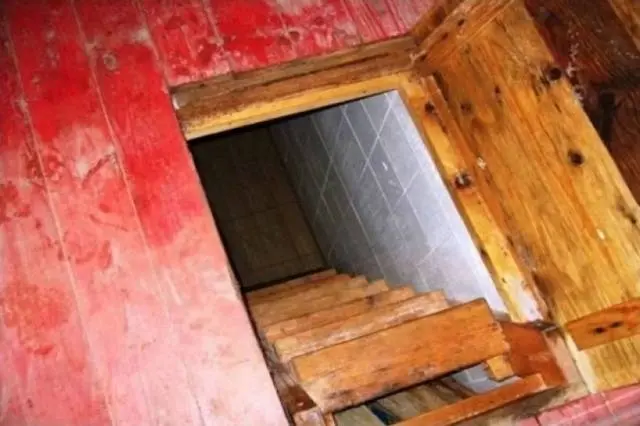
With a strong infection of the cellar with mold and fungus, disinfect it:
- Mechanically remove visible pockets of mold;
- Seal the room by closing the ventilation openings;
- Place quicklime in a barrel at the rate of 2-3 kg per 10 m3 cellars, fill with water and quickly leave the cellar, tightly closing the doors behind you. After two days, the cellar must be opened and thoroughly ventilated;
- In case of severe infection, repeat the procedure after a week, or use a sulfur checker, acting strictly according to the instructions for its use;
- Carry out the prevention of the appearance of rodents: seal all the cracks, install the mesh on the ventilation ducts;
- Lay out substances that repel rodents, or poisonous top dressing, arrange mousetraps.

Storing cabbage in a trench
In the absence of a cellar, you can store the cabbage crop in a trench, for this you need to dig a trench 60 cm wide and 50 cm deep on a hill. A layer of straw is laid out at the bottom, and heads of cabbage are placed on it in two rows. Next, there is again a layer of straw, on top of this embankment you need to put a wooden shield, and sprinkle on top with a layer of earth, 20 cm thick. When frosty weather sets in, the trench needs additional warming with straw.
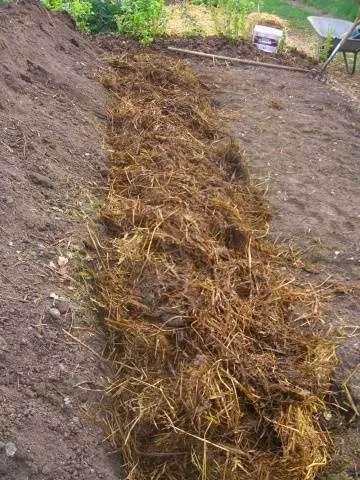
Watch a video that will clearly help you learn how to store cabbage in the cellar:










